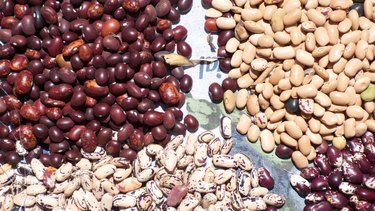
Many people think of starch as a mealtime side dish like potatoes or rice, but in terms of nutrition, a starch is simply a long chain of sugar molecules linked together, also known as a polysaccharide. Here's a look at how your body digests starch for fuel.
What Exactly Is Starch?
Video of the Day
It's natural to assume "starch" is just another name for carbohydrates. After all, aren't starchy foods high in carbs? Yes — but starch is just one of three types of carbohydrates, says the American Diabetes Association (ADA). It has a different molecular structure from sugar and fiber, the other two varieties of carbs, explains the nonprofit European Food Information Council (EUFIC).
Video of the Day
With a polysaccharide, long-chain structure, starch is classified as a complex carbohydrate — the healthier, more filling type you want to get plenty of in your diet, according to EUFIC. It can be found in foods like whole wheat, oats, corn and beans — and, of course, potatoes and rice, says ADA.
Digestion Starts in the Mouth
The goal of digestion is to break down foods into particles your body can use for fuel. Because starch has multiple bonds holding it together, your body has its work cut out for it in this process — and it all starts with your first bite.
"Carbohydrate digestion actually begins in your mouth as you start chewing," says Brittany Modell, RD, of Brittany Modell Nutrition and Wellness in New York City. Chewing begins the gradual process of breaking down starch's long chains. As you chew, your salivary glands also activate, stimulating the production of saliva.
"Your saliva contains an enzyme called salivary amylase," says Modell. "This enzyme starts to break apart starches into smaller, more simple carbohydrates," a process also known as hydrolysis. But because food doesn't stay in the mouth for very long, these enzymes are only doing preparatory work. The bulk of starch digestion is yet to come.
Middle Phases of Digestion
When you swallow, food passes through your esophagus down to your stomach. It's here that starch digestion stalls because the low acidic pH of the gastric juice in your stomach mostly stops the salivary amylase — the enzyme that worked to break down food when it was in your mouth — from further breaking down starch, according to an October 2016 report in Current Diabetes Reports. However, the stomach does work to physically mix and churn the food.
Moving past the stomach, starch continues on to the small intestine. It's in this part of the digestive tract that the real action of starch digestion happens, per May 2019 research in Frontiers in Nutrition.
When food (now churned into a substance called "chyme") enters the small intestine, the pancreas releases its own digestive enzymes to help break down starch, says Frontiers in Nutrition's research. This enzyme enters the small intestine through the pancreatic duct and gets to work on deconstructing starch into smaller chains and individual molecules.
In addition, the brush border of the small intestine contains other enzymes, such as maltase, sucrase and lactase, which also help with digestion and breaking down food, according to Colorado State University. The majority of starch digestion takes place in the small intestine, thanks to the activity of the enzymes in the pancreas and small intestine, notes Frontiers in Nutrition.
End Product of Starch Digestion
When all is said and done, starches have been broken down into their smallest, usable components: primarily the monosaccharide glucose, as well as some fructose and galactose. These simple sugars are known as the "end products" of starch digestion. Your body can now distribute them for use as energy or store them.
According to a study published in the August 2017 issue of the journal Starch, the glucose and galactose that result from starch digestion get distributed to the body's cells via two transport proteins, SGLT1 and GLUT2. Once in the cells, glucose and galactose can be used for energy.
Fructose, on the other hand, is transported via the proteins GLUT2 and GLUT5, according to research published in November 2015 in the journal Clinical and Translational Gastroenterology. It gets stored in the liver as a backup source of energy. And thus completes the body's process of digesting starch — until your next meal.
Read more: List of Foods That Contain Starch
- Brittany Modell, MS, RD, CDN, Brittany Modell Nutrition and Wellness, New York City
- Starch: “Starch Digestion in the Upper Gastrointestinal Tract of Humans”
- Clinical and Translational Gastroenterology: “Mechanisms of Fructose Absorption”
- American Diabetes Association: "Get to Know Carbs"
- European Food Information Council: "The Function of Carbohydrates in the Body"
- Current Diabetes Reports: “Salivary Amylase: Digestion and Metabolic Syndrome”
- Frontiers in Nutrition: “In vitro Digestibility of Dietary Carbohydrates: Toward a Standardized Methodology Beyond Amylolytic and Microbial Enzymes”
- Colorado State University: “Small Intestinal Brush Border Enzymes”
Is this an emergency? If you are experiencing serious medical symptoms, please see the National Library of Medicine’s list of signs you need emergency medical attention or call 911.